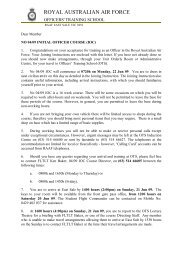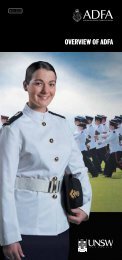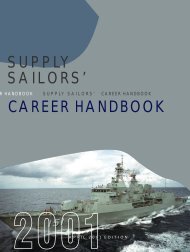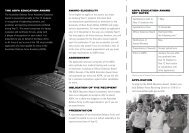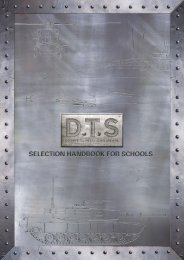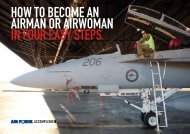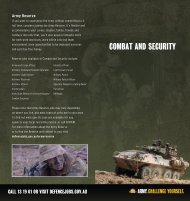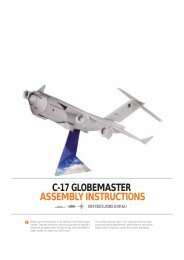WHaT IT TaKES TO bEcOmE a naval OffIcEr In fIvE EaSy STEPS.
WHaT IT TaKES TO bEcOmE a naval OffIcEr In fIvE EaSy STEPS.
WHaT IT TaKES TO bEcOmE a naval OffIcEr In fIvE EaSy STEPS.
Create successful ePaper yourself
Turn your PDF publications into a flip-book with our unique Google optimized e-Paper software.
WHAT <strong>IT</strong> TAKES<br />
<strong>TO</strong> become a<br />
<strong>naval</strong> officer<br />
in five easy STEPs.
step one.<br />
spend five minutes Checking<br />
out whether there’s a JOB<br />
that interests you.<br />
Decide what Officer role<br />
you want in the Navy.
“what kind of jobs do we offer”<br />
Flight deck<br />
OBSERVER<br />
pilot<br />
AERONAUTICAL ENGINEER<br />
engine room<br />
marine engineer officer
COMMUNICATIONS ROOM<br />
INTELLIGENCE OFFICER<br />
ship’s bridge<br />
seaman officer<br />
Headquarters<br />
CHAPLAIN<br />
INTELLIGENCE officer<br />
LEGAL OFFICER<br />
MAR<strong>IT</strong>IME TRADE OFFICER<br />
OPERATIONAL LOGISTICS OFFICER<br />
PSYCHOLOGIST<br />
TRAINING SYSTEMS OFFICER<br />
WEAPONS ELECTRICAL AIRCRAFT OFFICER<br />
medical centre<br />
MEDICAL OFFICER<br />
nursING OFFICER<br />
denTAL OFFICER<br />
operations room<br />
weapons electrical engineer officer<br />
OFFICES<br />
PUBLIC RELATIONS OFFICER<br />
SUPPLY OFFICER
THERE ARE MORE THAN 20 DIFFERENT JOBS YOU COULD DO<br />
AS AN OFFICER IN THE NAVY. THIS FIVE STEP GUIDE WILL<br />
HELP YOU DECIDE IF LIFE IN THE NAVY IS RIGHT FOR YOU.<br />
step ONE. find a job<br />
step TWO. become an officer P16<br />
step three. life in the navy P20<br />
step four. after joining P26<br />
step five. THE fine prinT P30<br />
5<br />
5
“leadership. it becomes<br />
critical when you’re at sea.”<br />
peter behrendt,<br />
seaman officer.<br />
What is an<br />
officer IN<br />
THE NAVY<br />
The Navy is divided into two very broad<br />
streams – Officers and Sailors. As an Officer<br />
in the Navy you’ll lead and supervise teams of<br />
Sailors in their chosen field of expertise as well<br />
as make decisions that will impact upon the<br />
operations of your ship, team or department.<br />
Being an Officer is an executive management<br />
and leadership role with a great deal of<br />
responsibility. The decisions you make will be<br />
based on sound judgement and an intelligent<br />
approach, leading people in a hands-on manner.<br />
You’ll be trained to be an expert, learning<br />
effective communication skills, management<br />
styles and character development skills.<br />
Your qualifications will be recognised Australia<br />
wide and you’ll get to work alongside people<br />
you admire and respect, some of whom will<br />
become like a second family. You’ll work in a<br />
challenging, exciting team environment and<br />
you’ll inspire those around you to maintain the<br />
team spirit that is essential to the success of<br />
any operation. Although being an Officer in the<br />
Navy is challenging, there’s plenty of adventure<br />
and diversity to look forward to. If this interests<br />
you, you should consider applying to become<br />
an Officer in the Navy. You'll never look back.<br />
DISCIPLINE<br />
Without discipline the Navy cannot operate<br />
effectively and safely. Navy discipline is based<br />
on reason and cooperation between those<br />
giving instructions and those receiving and<br />
following them. As an Officer in the Navy you<br />
are responsible for your Sailors and their<br />
welfare, so naturally you’ll need to be able to<br />
act with maturity and learn to work within a<br />
disciplined environment.<br />
LEADERSHIP<br />
If you have leadership aspirations then an<br />
Officer in the Navy is the career for you.<br />
Leadership is what defines an Officer in the<br />
Navy. Your role as an Officer not only involves<br />
adventure and excitement, but also the<br />
training and skills required to become a true<br />
leader who can handle responsibility. Within a<br />
team environment, you’ll pass through several<br />
phases of training – acquiring unique skills not<br />
just for work, but also for life, transferable to<br />
a variety of situations. It’s all part of building<br />
a great career that as a Seaman Officer could<br />
one day see you becoming the Captain of an<br />
Australian warship.<br />
As you develop your leadership skills, you will<br />
become part of the command team onboard,<br />
responsible for the control and safety of<br />
Navy vessels and crew. The unique training in<br />
the Navy means you have management and<br />
6<br />
leadership opportunities as an Officer early<br />
in your career.
OFFICER JOBS<br />
There are around 20 jobs you can do as an<br />
Officer in the Navy. At the end of each job<br />
description you will notice the method of<br />
SEAMAN OFFICER<br />
As a Seaman Officer you’ll control the<br />
movement and running of the ship. You are<br />
trained in navigation and warfare. Seaman<br />
Officers are the only people given the<br />
• Phase two consists of a period at sea,<br />
consolidating specialist training previously<br />
covered in phase one.<br />
• Phase three comprises a shore phase<br />
AERONAUTICAL ENGINEER<br />
OFFICER<br />
As an Aeronautical Engineer (AE) Officer<br />
you’ll face a diverse range of challenges with<br />
respect to the design integrity, configuration<br />
entry available. For more details on how you<br />
opportunity to become Commanding Officers<br />
focusing on navigation and bridge<br />
control and maintenance support of Navy<br />
can enter the Navy refer to Step Two in this<br />
brochure or for comprehensive job descriptions<br />
visit defencejobs.gov.au/navy<br />
of a warship. The first step is to become an<br />
'Officer of the Watch' working on the bridge,<br />
driving and navigating the ship. You are later<br />
given the opportunity to specialise in the area<br />
of navigation or warfare. Seaman Officers<br />
also perform the duties of managing a group<br />
of Sailors, looking after their welfare and<br />
advising them on their day-to-day duties.<br />
management followed by a six-month<br />
sea posting.<br />
• Phase four is a shore posting comprising<br />
bridge simulation and warfare training.<br />
Once qualified as a Seaman Officer, you<br />
may further your training to sub-specialise<br />
as a Principal Warfare Officer, Navigator,<br />
Hydrographic Surveyor, Mine Warfare Officer<br />
helicopters and flight simulators. You may<br />
find yourself working in a range of fields such<br />
as aircraft and weapons systems project<br />
development; research and development of<br />
repair schemes; modification, design and<br />
integration of sensors and control systems;<br />
airframe fatigue analysis and much more.<br />
The Junior Officer Warfare Application Course<br />
(JWAC) consists of four phases:<br />
and Clearance Diving Officer, Meteorology/<br />
Oceanography Officer or Submariner.<br />
Methods of Entry: AUSTRALIAN DEFENCE FORCE ACADEMY,<br />
GRADUATE ENTRY AND UNDERGRADUATE SPONSORSHIP.<br />
• Phase one teaches the basics of a Seaman<br />
Officer’s role and includes an initial sea<br />
METHODS OF ENTRY: AUSTRALIAN DEFENCE FORCE ACADEMY,<br />
DIRECT ENTRY AND UNDERGRADUATE SPONSORSHIP.<br />
training period.<br />
7
“i've actually rescued and saved some<br />
people which is both challenging and<br />
rewarding.”<br />
nic trimmer,<br />
helicopter pilot.<br />
MARINE ENGINEER OFFICER<br />
Marine Engineer Officers are in charge of the<br />
WEAPONS ELECTRICAL<br />
ENGINEER OFFICER<br />
DENTAL OFFICER<br />
Dental Officers maintain the dental health of<br />
MEDICAL OFFICER<br />
As a Navy Medical Officer you are responsible<br />
mechanical systems onboard a ship, and the<br />
structural integrity of the ship’s hull and heavy<br />
power distribution. This takes in everything<br />
from diesel to gas turbine propulsion<br />
machinery, diesel power generators and<br />
hydraulic systems. Marine Engineers also<br />
lead a team of technicians who repair and<br />
maintain this equipment. As a Marine Engineer<br />
Officer you’ll undertake the Marine Engineer<br />
Application Course which will familiarise you<br />
with relevant Navy equipment and procedures.<br />
Method of Entry: AUSTRALIAN DEFENCE FORCE ACADEMY,<br />
GRADUATE ENTRY AND UNDERGRADUATE SPONSORSHIP.<br />
As a Weapons Electrical Engineer Officer you<br />
are responsible for the electronics and weapons<br />
systems onboard warships. This includes all the<br />
communication and navigation equipment as<br />
well as the weapons and combat data systems.<br />
These include radar, sonar, missile launchers<br />
and computer equipment. You’ll also lead a<br />
team of technicians who repair and maintain<br />
this equipment. Weapons Electrical Engineer<br />
Officers undertake a Weapons Engineer Course.<br />
The course covers learning how to maintain<br />
gun and missile fire-control systems, navigation<br />
systems, air and ground communications as well<br />
as radar and combat data systems.<br />
Methods of Entry: AUSTRALIAN DEFENCE FORCE ACADEMY,<br />
GRADUATE ENTRY AND UNDERGRADUATE SPONSORSHIP.<br />
Navy personnel. You’ll work in well-equipped<br />
surgeries supported by well-trained nursing and<br />
clerical teams, which mean you also have the<br />
benefit of providing the required treatments<br />
whenever you feel that it’s necessary. Dental<br />
Officers serve both at sea and ashore. To be<br />
eligible to become a Dental Officer you must be<br />
registered as a medical practitioner under the<br />
laws of the Commonwealth, state or territory,<br />
or hold qualifications that make you eligible for<br />
such registration.<br />
Methods of Entry: GRADUATE ENTRY AND UNDERGRADUATE<br />
SPONSORSHIP.<br />
for the health of Navy personnel. This takes<br />
in the area of general practice as well as<br />
specialised areas such as aviation medicine,<br />
underwater medicine and occupational health<br />
and safety. Medical Officers work in the most<br />
well equipped surgeries surrounded by trained<br />
nursing and clerical teams. Medical Officers<br />
serve both at sea and ashore. Medical Officers<br />
must be registered as medical practitioners<br />
under the laws of the Commonwealth,<br />
state or territory or hold qualifications that<br />
make you eligible for such registration.<br />
Methods of Entry: GRADUATE ENTRY, UNDERGRADUATE<br />
SPONSORSHIP, GRADUATE MEDICAL SCHEME AND NAVAL<br />
RESERVE.<br />
8
NURSING OFFICER<br />
As a Nursing Officer you will support Medical<br />
Officers in maintaining the health and fitness<br />
of the Navy’s personnel. Nursing Officers<br />
are skilled in medical, surgical and trauma<br />
nursing. You may also specialise in areas<br />
such as aviation medicine and underwater<br />
medicine. Serving both at sea and ashore,<br />
Nursing Officers will work with highly trained<br />
staff in well-equipped surgeries and hospitals.<br />
Nursing Officers must be either registered<br />
or hold a degree or diploma in nursing with<br />
at least 12 months recent nursing experience<br />
and a current practising certificate from the<br />
registration board.<br />
Method of Entry: GRADUATE ENTRY, UNDERGRADUATE<br />
SPONSORSHIP AND NAVAL RESERVE.<br />
OBSERVER<br />
Observers in the Navy are responsible<br />
for warfare or tactical operations of the<br />
helicopter. You’ll function as a co-pilot,<br />
working in the areas of air navigation,<br />
contact assessment and evaluation, weapons<br />
employment and tactical coordination.<br />
Observers also have managerial, logistic<br />
and administrative responsibilities. You<br />
could eventually command a squadron of<br />
helicopters, be involved in aircraft trials or<br />
project development.<br />
Phase one of training involves Air Navigation<br />
in fixed wing and trainer aircraft whilst phase<br />
two involves training in rotary wing aircraft.<br />
<strong>In</strong> addition there is Combat Survival Training<br />
as well as Flying Training in a specific Navy<br />
operational helicopter. The Navy Observer's<br />
Course also involves Aviation Medicine<br />
Training.<br />
MethodS of Entry: AUSTRALIAN DEFENCE FORCE ACADEMY<br />
AND DIRECT ENTRY.<br />
9
10<br />
10
PILOT<br />
As a Pilot (Aviation Officer) you are responsible<br />
for flying the Navy’s helicopters, which include<br />
the Seahawk, Sea King and Squirrel. The<br />
Seahawk provides the opportunity to use<br />
state-of-the-art ‘glass cockpits’ with a level of<br />
sophistication equal or better than that found<br />
on a F/A-18 fighter jet and other modern fixed<br />
wing aircraft. Pilots have the challenge of flying<br />
in demanding conditions – day and night, in<br />
all weather conditions, from the constrained<br />
environment of a ship’s flight-deck. Before<br />
joining ships at sea, Navy pilots undergo<br />
26 weeks of Basic Military Flying Training at<br />
British Aerospace Flight Training Australia in<br />
Tamworth, NSW.<br />
This is followed by 40 weeks of Military Flying<br />
Training at RAAF Base Pearce in WA. Trainee<br />
pilots cover all areas of aviation and navigation<br />
studies including the science and mathematics<br />
of Aircraft Operations, Combat Survival Training,<br />
Military Flying Training, Rotary Wing Aircraft<br />
Training, Airmanship, Air Traffic Control,<br />
Aviation Medicine and Helicopter Flying. Upon<br />
completion you will be awarded your ‘wings’.<br />
WEAPONS ELECTRICAL<br />
AIRCRAFT OFFICER<br />
As a Weapons Electrical Aircraft (WEA) Officer<br />
you will be challenged with the responsibility<br />
of the weapons systems onboard the Navy’s<br />
fleet of sophisticated helicopters, unmanned<br />
target aircraft and flight simulators. This may<br />
include integrated logistics management of<br />
specific weapons systems; aircraft and weapons<br />
systems project development modification;<br />
design and integration of sensors, control<br />
systems and airborne mission systems; or with<br />
experience you could become a Squadron Senior<br />
Engineering and Maintenance Manager.<br />
Methods of Entry: AUSTRALIAN DEFENCE FORCE ACADEMY,<br />
GRADUATE ENTRY AND UNDERGRADUATE SPONSORSHIP.<br />
Method of Entry: AUSTRALIAN DEFENCE FORCE ACADEMY<br />
AND DIRECT ENTRY.<br />
“NAVIGATING A SHIP IN A TASK GROUP OF 15 OTHER<br />
SHIPS FROM AROUND THE WORLD IS SOMETHING NOT<br />
MANY OTHER PEOPLE HAVE SEEN, LET ALONE DONE.”<br />
ADAM SIMEONI,<br />
seaman officer. 11
“ iT’S NEVER AN EASY DAY AT WORK. THERE’S ALWAYS<br />
SOMETHING HAPPENING, SO FOR THAT REASON<br />
I THINK <strong>IT</strong>'S BUILDING ME UP <strong>TO</strong> BE<br />
A BETTER MANAGER IN THE FUTURE.”<br />
LINDSAY GORDON,<br />
MARINE ENGINEER OFFICER.<br />
12
SUPPLY OFFICER<br />
As a Supply Officer you'll ensure the<br />
Navy’s ships, submarines, aircraft and<br />
personnel receive the resources required<br />
to perform their operations. Trained<br />
in logistics and management, you will<br />
control cash disbursement, personnel<br />
management, logistics planning, catering<br />
and financial accounting. The Supply<br />
Officers’ Course consists of two phases:<br />
SOAC Phase I is a residential course held<br />
at HMAS CERBERUS and is approximately<br />
4 months. The course focuses on the core<br />
Supply functions of the Supply Sailor at sea;<br />
an introduction to support organisations<br />
focusing on support ashore for Major Fleet<br />
Units (MFUs); and the role of the Supply<br />
Officer at sea. The course includes a roadshow<br />
at the end of the course to solidify learning<br />
with an opportunity to meet the agencies<br />
who provide ashore support to MFUs.<br />
SOAC Phase II as an Assistant Supply<br />
Officer (ASO) involves a posting of<br />
approximately 12 months to a Major<br />
Fleet Unit (MFU) on completion of<br />
SOAC Phase 1. You will undertake the<br />
role of the ASO while progressing your<br />
Professional Skills Journal, which you will<br />
have been issued with during Phase I.<br />
The ASO will assume responsibility for service<br />
funds, finance and logistic administration.<br />
The ASO has standardised responsibilities<br />
across all platforms and will also develop<br />
foundation knowledge in departmental<br />
and material management in preparation<br />
for their Supply Primary Qualification<br />
board. It is on successful completion of<br />
the board that the trainee Supply Officer<br />
is awarded the SU (Supply) qualification.<br />
Method of Entry: AUSTRALIAN DEFENCE FORCE ACADEMY,<br />
DIRECT ENTRY AND UNDERGRADUATE SPONSORSHIP.<br />
TRAINING SYSTEMS OFFICER<br />
A Training Systems Officer’s job is to provide<br />
the Navy with qualified, professional trainers.<br />
You’ll become a specialist in management,<br />
training analysis and design as well as training<br />
issues and delivery. Training Systems Officers<br />
will be involved in tasks such as training<br />
development and workplace assessment.<br />
Method of Entry: GRADUATE ENTRY AND NAVAL RESERVE.<br />
13
LEGAL OFFICEr<br />
The Navy lives by the same laws as the<br />
community and by the special laws which<br />
CHAPLAIN<br />
The Navy has a diverse religious community<br />
that employs ministers of religion as<br />
SUBMARINE SERVICE<br />
Submarines exist in a world unseen by most<br />
and experienced by a lucky few. Travelling the<br />
RESERVE JOBS<br />
INTELLIGENCE OFFICER<br />
govern the Australian Defence Force. As a Navy<br />
Legal Officer you’ll perform advocacy tasks in<br />
such tribunals as Navy Courts Martial and Navy<br />
Boards of <strong>In</strong>quiry. You’ll provide legal advice<br />
in relation to policy, the Law of Armed Conflict<br />
and the Law of the Sea and you will also provide<br />
counselling to Naval staff. All Legal Officers<br />
must be registered as barristers or solicitors<br />
of the High Court of Australia, Supreme<br />
Court of a state or territory of Australia or<br />
have passed all exams for admission.<br />
Following completion of the New Entry<br />
Officer Course, Legal Officers will complete<br />
Chaplains. As a Navy Chaplain you’ll remain<br />
faithful to your own principles and traditions,<br />
but provide education and support to<br />
personnel, whatever their religious beliefs<br />
or backgrounds. Character development<br />
training and counselling make up other<br />
responsibilities, which include anything from<br />
specialised counselling during a major crisis<br />
to more informal chats and group discussions.<br />
Chaplains are subject to the same entry<br />
requirements as other Officer applicants, but<br />
must also obtain the appropriate ecclesiastical<br />
credentials and endorsements.<br />
ocean unseen and unheard in a technologically<br />
advanced Collins Class Submarine, you’ll be<br />
sharing your experiences with a close-knit<br />
crew, who you’ll form strong relationships with<br />
and rely on for ultimate success. Submariners,<br />
often referred to as the ‘astronauts of the<br />
deep’, have proud traditions and demand very<br />
high standards from the men and women<br />
within their ranks. This ensures a dedicated<br />
and professional outfit who are indeed a<br />
‘breed apart’.<br />
Submariner Officer jobs available:<br />
Seaman Officer, Marine Engineer Officer,<br />
Reserve <strong>In</strong>telligence Officers in the Navy<br />
enjoy reading and analysing current issues<br />
and movements in news from around the<br />
globe. Your duties may include presenting<br />
informed and detailed briefs, interpreting<br />
and translating foreign languages or<br />
analysis of electronic warfare information.<br />
<strong>In</strong>telligence Officers work in a highly<br />
classified environment and play a vital role in<br />
national security.<br />
Method of Entry: NAVAL RESERVE.<br />
a short Legal Officers’ Application Course.<br />
You will also do an induction period at a<br />
Navy Base or at Maritime Headquarters,<br />
in Sydney, for up to 12 months.<br />
Method of Entry: GRADUATE ENTRY AND NAVAL RESERVE.<br />
Weapons Electrical Engineer Officer.<br />
Method of Entry: australian defence force academy,<br />
direct entry and undergraduate sponsorship.<br />
14<br />
Method of Entry: GRADUATE ENTRY AND NAVAL RESERVE.
MAR<strong>IT</strong>IME TRADE OFFICER<br />
OPERATIONAL LOGISTICS OFFICER<br />
PSYCHOLOGIST<br />
PUBLIC RELATIONS OFFICER<br />
As a Maritime Trade Officer you are responsible<br />
As an Operational Logistics Officer (OPLOG)<br />
As a Psychologist in the Naval Reserve you’ll<br />
As a Public Relations Officer you'll be in<br />
for monitoring and advising the movements of<br />
your role is to coordinate logistics support<br />
provide psychological services that include<br />
charge of upholding and promoting a positive<br />
merchant shipping. You may also be required to<br />
for Navy operations both onshore and at<br />
stress management and combat stress, monitor<br />
image of the Navy amongst the community.<br />
control all shipping activity within designated<br />
sea. You’ll operate on strategic and tactical<br />
the morale and psychological wellbeing of<br />
By utilising skills in journalism and marketing<br />
threat areas. The position offers a variety of<br />
levels and you’ll be involved with planning<br />
members, give advice to commanders and<br />
you will produce media releases, coordinate<br />
work at Maritime Headquarters in Sydney, as<br />
operational logistics and providing logistic<br />
specialists and handle various human resource<br />
media liaison and assist media in news<br />
well as shipping control points nationwide.<br />
policy formulation and training. Operational<br />
issues. You will also be responsible for the<br />
gathering. To become a Public Relations<br />
To be eligible, you need to have qualifications or<br />
logistics involve the provision of policy advice<br />
psychological wellbeing of Navy members<br />
Officer, formal qualifications (preferably a<br />
experience in the civil maritime industry either<br />
and planning for Australian Defence Force<br />
before and after operational deployment. To be<br />
degree) in Public Relations, Public Affairs<br />
onboard a ship or in a shore-based maritime<br />
actions in war and on exercises. It is also<br />
eligible you must have an existing Psychology<br />
or Communications or at least three years<br />
role or as a full-time Seaman Officer with<br />
concerned with tactical level support of Fleet<br />
degree and be registered to practise in at<br />
experience in a related field is required.<br />
recent operations or headquarters experience.<br />
Subject to Navy approval, special consideration<br />
may be given to exceptional applicants who<br />
units, either from a parent establishment<br />
or from a forward deployed support unit in<br />
Australia or possibly overseas.<br />
least one Australian state or territory.<br />
METHODS OF ENTRY: NAVAL RESERVE.<br />
Methods of Entry: NAVAL RESERVE.<br />
demonstrate a keen maritime interest together<br />
with a specialised qualification in management<br />
Methods of Entry: Naval Reserve.<br />
or other relevant skills.<br />
Methods of Entry: NAVAL RESERVE.<br />
15
16<br />
step two.<br />
THERE ARE SEVERAL WAYS<br />
<strong>TO</strong> BECOME AN OFFICER.<br />
WHICH ONE IS RIGHT FOR YOU
Avenues<br />
of entry.<br />
Australian Defence<br />
Force AcadEmy<br />
The Australian Defence Force Academy (ADFA)<br />
is part of the University of New South Wales,<br />
located in Canberra. It’s where the Navy<br />
primarily provides tertiary education for its<br />
Officers, offering degrees in Arts, Science,<br />
Engineering, Business and a Bachelor of<br />
Technology—Aviation (only available to pilot and<br />
observer applicants). It offers the best teacher to<br />
student ratio and superb resources and facilities,<br />
such as 23 hectares of sporting fields and an<br />
indoor sports centre widely considered to be<br />
one of Australia’s best. When you finish, you’ll<br />
graduate with a degree as if you were studying<br />
at the Sydney campus. The Academy also offers<br />
opportunities for study and research at postgraduate<br />
levels leading to Graduate Diplomas as<br />
well as Masters and Doctoral degrees.<br />
ADFA Navy Officer training is unique in that<br />
you can ‘try before you buy’ in your first year.<br />
During what is referred to as the Naval Officer<br />
Year One Scheme, you’ll spend the first six<br />
months at the Royal Australian Naval College<br />
at HMAS CRESWELL in Jervis Bay (excluding<br />
Aviation Officers who go direct to ADFA).<br />
You’ll experience Navy-specific training in your<br />
chosen field which will include leadership and<br />
management studies. This will prepare you for<br />
up to six months on-the-job training at various<br />
locations around Australia depending on your<br />
chosen career. You will learn to work in a team<br />
with Sailors that you may eventually lead. <strong>In</strong><br />
your second year you will begin your tertiary<br />
studies at the Academy. Best of all, you won’t<br />
pay any tuition fees and the Navy will pay you<br />
over $20,000p.a. while you study. Plus you will<br />
get free medical and dental care. The real reward<br />
of this training in effectively leading a close<br />
and professional team, is how much you’ll learn<br />
about yourself.<br />
For more information about ADFA, visit<br />
defencejobs.gov.au/ADFA or call 13 19 01.<br />
17<br />
17
“<strong>IT</strong>’S NICE <strong>TO</strong> KNOW WE’RE ACHIEVING<br />
OUR ULTIMATE AIM OF PROTECTING<br />
AUSTRALIA’S WATERS.”<br />
PENNI BUCHANAN,<br />
seaman officer.<br />
ADFA education award<br />
The Navy grants education awards to selected<br />
full-time secondary school students who apply<br />
to join the Australian Defence Force Academy.<br />
Applications must be made during Year 11 after<br />
the receipt of mid-year results.<br />
Call 13 19 01 or visit your local Defence Force<br />
Recruiting Centre for more information.<br />
ELIGIBIL<strong>IT</strong>Y FOR ADFA<br />
To be eligible to apply for ADFA, you will need<br />
to be at least 17 years of age on date of entry<br />
to the Academy. You will need to be studying<br />
or have completed Year 12 (with at least<br />
passes in English, Mathematics and two other<br />
subjects) and have results that qualify you for<br />
entry to the University of New South Wales,<br />
or you may be currently studying at another<br />
university. After applying, you’ll go through a<br />
selection process that will determine whether<br />
you have the physical and mental attributes<br />
to become a Navy Officer. All applications to<br />
ADFA must be submitted to a Defence Force<br />
Recruiting Centre.<br />
Refer to defencejobs.gov.au/navy or call<br />
13 19 01 for more specific information.<br />
Direct Entry OFFICER<br />
18<br />
If you haven't had the chance to go to<br />
university, that won't stop you becoming an<br />
Officer. Direct Entry is the fast track route to<br />
becoming an Officer in the Navy and you don't<br />
need previous Naval or Military experience<br />
to qualify. You'll get the same training and<br />
benefits as other Officers, and the chance<br />
to make decisions, take responsibility and
e a leader in your workplace. If you like a<br />
challenge and want a choice of great jobs,<br />
becoming an Officer is the place to start.<br />
There are several Officer jobs available<br />
(Seaman Officer, Pilot, Observer and Supply<br />
Officer) that don’t require a degree, so<br />
Direct Entry is a great fast track to an<br />
executive career.<br />
Eligibility for DIRECT ENTRY<br />
To qualify you should have completed Year 12<br />
with passes in English and three other tertiary<br />
accredited subjects. If you haven’t completed<br />
Year 12, the Navy will consider your relevant<br />
work experience and other qualifications you<br />
may have gained.<br />
graduate opportunities<br />
If you already have a university degree,<br />
consider a place that will test your skills<br />
and knowledge from day one. If you're a<br />
graduate in medicine, engineering, teaching,<br />
nursing or dentistry, there's no better way<br />
to kick-start your career than as an Officer<br />
in the Navy. You'll earn your rank right<br />
from the start. Graduates from a four-year<br />
course of study are granted the rank of Sub<br />
Lieutenant and Graduates from a three-year<br />
course are granted the rank of Midshipman.<br />
A longer course of study or relevant work<br />
experience may also be recognised with<br />
additional levels of seniority considered as<br />
appropriate. Whether you start off as a Sub<br />
Lieutenant or Midshipman, you’ll be working<br />
with cutting edge equipment, leading and<br />
making decisions, while receiving the training<br />
you need to always improve. We'll even give<br />
you the chance to further your qualifications<br />
during your career as an Officer.<br />
Eligibility for Graduates<br />
Graduates must have either obtained degrees<br />
from an Australian university or an overseas<br />
institution. Qualifications gained overseas<br />
must be recognised by an appropriate<br />
Australian professional body and will be<br />
considered on a case-by-case basis.<br />
ADF SPONSORED<br />
Undergraduate<br />
<strong>In</strong> certain cases the Navy will offer<br />
Undergraduate Sponsorships while you finish<br />
your degree at your existing university. The<br />
Navy can offer sponsorships for Undergraduate<br />
Engineering and Law students for up to three<br />
years and Medical and Dental students for up to<br />
four years. Seaman Officers and Supply Officers<br />
can also join as sponsored Undergraduates.<br />
You'll receive up to $32,800p.a. to study,<br />
payment of tuition and compulsory union fees,<br />
an allowance for essential books and equipment,<br />
subsidised accommodation (if living away from<br />
home) and free healthcare.<br />
ELIGIBIL<strong>IT</strong>Y FOR ADF<br />
SPONSORED Undergraduate<br />
Undergraduates must have successfully<br />
completed at least one year of a university<br />
degree applicable to the Navy. You must also<br />
have passed the prescribed examinations for<br />
each year of the course up to the date of entry.<br />
<strong>naval</strong> reserve<br />
If you want the responsibility and adventure<br />
of being an Officer without the full-time<br />
commitment, then the Naval Reserve could<br />
be for you. You get similar training and<br />
experience as full-time members, without<br />
having to sacrifice your civilian life. You'll be<br />
doing a job that's worthwhile and play a key<br />
role in Australia's security. Reservists come<br />
from all walks of life. Some are ex full-time<br />
personnel who have discharged from the Navy,<br />
whilst others have recently undertaken Navy<br />
specific training, which they combine with the<br />
skills they bring from the civilian world.<br />
Ashore, Reservists serve in each state capital<br />
or wherever there is a <strong>naval</strong> presence.<br />
Reservists are also deployed overseas to<br />
support the United Nation’s humanitarian<br />
efforts in making a difference to the lives of<br />
people affected by disaster and civil unrest.<br />
Recently Reservists have served in the<br />
Solomon Islands, Somalia, Rwanda,<br />
<strong>In</strong>donesia, Papua New Guinea, Bougainville,<br />
East Timor and the Persian Gulf. They have<br />
also been involved in border control and<br />
fishery protection.<br />
As a Naval Reservist you get the opportunity<br />
to practise your chosen career while earning<br />
a tax-free salary and have the full benefits of<br />
the Navy Health Medical Benefits Scheme.<br />
As a Naval Reserve Officer you’ll undertake<br />
the Reserve Entry Officers' Course at the<br />
Royal Australian Naval College (RANC) and<br />
also via distance education modules.<br />
initial officer training<br />
<strong>In</strong>itial Officer Training, or IOC, is undertaken by<br />
all Officers who join the Navy. It forms a part<br />
of the New Entry Officer Course, the Reserve<br />
Entry Officer Course, the Undergraduate Entry<br />
Officer course and the Australian Defence<br />
Force Academy. The training you undertake<br />
depends on your method of entry. The <strong>In</strong>itial<br />
Officer Training begins with 22 weeks at the<br />
Royal Australian Naval College (RANC), HMAS<br />
CRESWELL at Jervis Bay, NSW.<br />
You’ll learn about our history, how the Navy<br />
works, and specific subject areas that will<br />
provide you with the general skills you'll<br />
need to lead and manage your Sailors.<br />
Outside, you’ll undertake physical fitness<br />
and adventure training, and spend time at<br />
sea during a training cruise. <strong>In</strong>itial training<br />
encompasses:<br />
• Management and leadership skills<br />
• Officer development<br />
• First aid and small arms training<br />
• Character guidance<br />
• Oral and written communication<br />
• Defence studies<br />
• Physical training and adventure training<br />
(Abseiling, caving and high ropes)<br />
• Sea training and other Naval / mariner skills.<br />
After this you’ll go on to complete professional<br />
application training in your specialist field.<br />
NEW ENTRY<br />
OFFICER COURSE<br />
For most people who want to be an Officer in<br />
the Navy, this is the most common avenue of<br />
entry. It’s open to those who have passed Year<br />
12 without a degree, people who have existing<br />
degrees, or graduates with a degree relevant<br />
to a Navy job. It runs for approximately<br />
six months and is broken up into two main<br />
sections. The first four weeks is the <strong>In</strong>itial<br />
Training Period where you learn the basics<br />
of <strong>naval</strong> life such as Navy ceremony, physical<br />
fitness, living with your new mates and how<br />
to wear your uniform correctly. Here you’ll<br />
understand that your primary responsibility is<br />
the welfare of your Sailors and what it means<br />
to uphold the Navy's core values of Honour,<br />
Honesty, Courage, <strong>In</strong>tegrity and Loyalty. You<br />
will develop team leader and team member<br />
qualities and enjoy the mateship of your fellow<br />
Junior Officers.<br />
19
step tHREE.<br />
SPEND A FEW MINUTES<br />
LEARNING ABOUT LIFE<br />
IN THE NAVY.<br />
20<br />
“TEAMWORK ON THE AIRCRAFT IS PARAMOUNT AND YOU<br />
HAVE <strong>TO</strong> WORK <strong>TO</strong>GETHER AS A CREW <strong>TO</strong> GET THE JOB<br />
DONE. I LOVE MY JOB. I ALWAYS GET A BUZZ OUT OF <strong>IT</strong>.”<br />
MARELO LAGO,<br />
OBSERVER.
What kind of<br />
people join<br />
All kinds of people. But they all have<br />
something in common. They have a willingness<br />
to work hard and adapt to new situations.<br />
They’re team players. They like to work with<br />
other people to make things happen. They’re<br />
prepared to go to sea. They also don’t mind<br />
a bit of fun. As an Officer, you’ll also learn<br />
to be a leader, managing a team of people.<br />
It’s essentially an executive role, so if you like<br />
responsibility, this is the job for you.<br />
What’s life like<br />
in the Navy<br />
There’s nothing quite like life in the Navy.<br />
Sure, there’s responsibility but there’s also<br />
time out for fun with your new found mates.<br />
That’s something you won’t find in an office<br />
in civilian life. Life in the Navy is not all about<br />
being at sea. You’ll spend time working<br />
onshore in Australia and internationally.<br />
You’ll work with great people, cutting<br />
edge technology and learn leadership and<br />
management skills that you’ll have for life.<br />
Ships are organised on a rotational basis. So<br />
you may be two months away and two months<br />
at home, or a week at sea and a weekend at<br />
home, or even a day at sea and home again<br />
that evening. It all depends on the type of<br />
vessel you’re assigned to.<br />
Life in the Navy is never dull. You are<br />
constantly challenged, from the moment<br />
you commence training, to your first official<br />
exercise. Whether out at sea, where the sense<br />
of adventure and fun is high, or posted ashore<br />
where you'll enjoy the early finishing time<br />
and amazing recreational facilities, Navy life<br />
is exciting. Ask anyone in the Navy about<br />
their lives and they’ll tell you stories of travel,<br />
friendships and adventure. <strong>In</strong> some cases<br />
they’ll also tell you about being involved in<br />
world events that changed their lives and the<br />
lives of others.<br />
Life at sea<br />
Navy life is characterised by two distinct<br />
periods: life at sea and life ashore. Depending<br />
on your job, you’ll probably spend about equal<br />
time on land and at sea. A Seaman Officer, for<br />
example will spend more time at sea than a<br />
Supply Officer.<br />
Onboard is really where all the action happens.<br />
It’s an amazing feeling, heading out to sea with<br />
the whole crew pitching in to make it happen.<br />
There’s nothing like standing out on deck on a<br />
still night, in the middle of the ocean, looking<br />
up at the stars. Of course, it’s on the ship<br />
that all your training in teamwork pays off.<br />
There’s a constant sense of activity onboard,<br />
as teams of Officers and Sailors work together,<br />
rotating in shifts, keeping the ship maintained,<br />
protected and on course. Officers usually sleep<br />
in shared accommodation as Junior Officers.<br />
You’ll also dine with your fellow Officers in<br />
the ‘Wardroom’. You’ll sail around Australia,<br />
training and doing exercises with other<br />
countries like the USA, New Zealand or the<br />
UK. You could be away from your home<br />
port for as long as four months, however,<br />
usually you won’t spend more than two<br />
weeks straight at sea.<br />
You could be in a foreign port for up to a week,<br />
where you can take time off to see the sights.<br />
While you’re at sea you’ll usually have access<br />
to email and regular mail.<br />
JOB DIVERS<strong>IT</strong>Y<br />
There’s plenty of job diversity onboard ships.<br />
Depending upon the class of ship you could:<br />
• Act as a member of the Ship's medical<br />
emergency, damage control, and<br />
firefighting teams<br />
• Act as a member of the flight deck team in<br />
support of the Ship's helicopter<br />
• Undertake biological and chemical defence<br />
training, and ongoing renewal of these skills<br />
• Act as a member of a boarding party.<br />
LIFE WHEN YOU’RE NOT<br />
AT SEA<br />
When you’re ashore, generally you do the<br />
same job you would do when you’re onboard<br />
the ship. For example, a Marine Engineer<br />
Officer would work on base in charge of<br />
servicing ships and boats in port and doing<br />
other repairs. A Nursing Officer would work<br />
in a hospital rather than in the medical centre<br />
onboard the ship. There are a few roles that<br />
can only be carried out at sea, for example,<br />
Seaman Officers are posted to administration,<br />
ship support and fleet planning duties.<br />
There's interesting positions in human<br />
resource management, training, and project<br />
development between sea postings.<br />
<strong>IT</strong>’S AN IMPORTANT JOB<br />
The Navy defends Australia’s coast and<br />
surrounding waters, helping out in times of<br />
crisis and occasionally assisting neighbouring<br />
countries. You’re probably aware of the<br />
Navy’s involvement in emergency rescues<br />
and situations of conflict. These are typical<br />
events in the Navy. On a day-to-day level,<br />
the Navy’s patrol boat fleet protects our<br />
waters from illegal fishing, drug-running and<br />
illegal immigration. The Navy also helps out<br />
Australians during times of flood, drought or<br />
other natural disasters. For many in the Navy,<br />
this is what makes their job stand out.<br />
21
HARDWARE<br />
No doubt about it, if you like machines –<br />
especially big machines, then the Navy is for<br />
you. Most likely, the first ship you’re posted<br />
to will be an ANZAC Class 3600 tonne frigate<br />
measuring 118 metres with one gas turbine and<br />
two twelve-cylinder diesel engines almost as<br />
big as your garage. Onboard this same frigate<br />
you’ll find missile launchers, anti-submarine<br />
torpedoes, a five-inch gun and six 12.7mm<br />
machine guns. There’s also more specialised<br />
craft such as the Collins Class Submarine, one<br />
of the most advanced conventionally powered<br />
diesel/electric submarines in the world. There<br />
are also high-tech mine-hunting vessels,<br />
hydrographic vessels (used for mapping our<br />
oceans), plus a whole fleet of patrol boats<br />
including the Armidale Class Patrol Boat<br />
(ACPB) which comb the Australian coast,<br />
keeping our waters safe. Then, of course,<br />
some of our most exciting machines don’t<br />
even belong in the water. The Navy’s aviation<br />
arm includes one of the most advanced antisubmarine<br />
warfare helicopters in the world–<br />
the Seahawk. There’s always new and exciting<br />
equipment being used and ships are coming<br />
online all the time, so there’ll be little chance<br />
of getting stuck in a rut.<br />
Friends<br />
The Navy is a job for team players. You’ll work<br />
closely with your colleagues and soon become<br />
great friends. <strong>In</strong> fact, you will have made some<br />
friends in your first few days of Navy life that<br />
will last a lifetime.<br />
Even people who’ve only been in the Navy a<br />
few weeks talk about their new ‘family’. It’s<br />
one of the best parts of Navy life.<br />
Accommodation<br />
Once you finish initial training you’ll either<br />
live onboard a ship (if you’re posted to<br />
sea), on the base you’ve been posted to,<br />
or you may be entitled to rental assistance<br />
and choose to live in the local community.<br />
If you’re married, the Navy will subsidise<br />
the rent on a house for you and your<br />
family, no matter where you’re working.<br />
RECREATION<br />
Believe it or not, there’s a lot of time in<br />
the Navy for fun. So, to help you out, we<br />
have cafés, sports facilities, football ovals,<br />
basketball courts, tennis courts, swimming<br />
pools, gymnasiums, and social clubs. Even<br />
when you’re at sea, you’ll have access to<br />
recreational facilities like gymnasiums, lounge<br />
rooms and the latest movies via the CCTV<br />
(Closed Circuit Television) network. Not to<br />
mention– you’ll also have the whole world at<br />
your feet.<br />
WOMEN IN THE NAVY<br />
Women are trained just the same way as men<br />
are, which means they’re expected to perform<br />
equally, with some physical considerations.<br />
There are several female Commanding<br />
Officers in the Navy and certainly hundreds<br />
of Officers and Sailors. Nowadays, women<br />
are also serving in the submarine service. Of<br />
course, on base and onboard ships, amenities<br />
and sleeping facilities are arranged to provide<br />
maximum privacy for both males and females.<br />
Food<br />
The Navy’s point of view is, ‘a happy crew<br />
is a crew that’s well-fed’. So, one thing<br />
you’ll get plenty of in the Navy is food–<br />
good quality food too. The Navy can cater<br />
for special diets on request.<br />
22
“AS AN ENGINEER, THE NAVY OFFERS A<br />
WIDE ARRAY OF CAREER DEVELOPMENT<br />
OPPORTUN<strong>IT</strong>IES INCLUDING SPECIALISED<br />
TRAINING PROGRAMS AND THE OPPORTUN<strong>IT</strong>Y<br />
<strong>TO</strong> MANAGE A RANGE OF PROJECTS.”<br />
RHYS COWLING,<br />
AERONAUTICAL ENGINEER Officer.<br />
23
JANE<br />
LANDON<br />
a short interview with<br />
JANE LANDON, a SEAMAN<br />
OFFICER, ABOUT life at sea.<br />
24<br />
24
WHY DId YOU JOIN THE NAVY<br />
I was studying at university and became<br />
frustrated by the routine of classes and<br />
part-time jobs; I decided that I needed more<br />
adventure and challenge in my career path.<br />
How did you learn about<br />
the Navy<br />
My father and brother are both in the Navy, so<br />
I had quite a bit of exposure to the Navy when<br />
I was growing up.<br />
What was it like at the Royal<br />
Australian Naval College<br />
I had a great time at the Naval College. HMAS<br />
Creswell is a lovely base and there are plenty<br />
of opportunities to make the most of the<br />
beaches, golf course and sport & rec facilities.<br />
I also have great memories of competing in<br />
the ‘Beach Olympics’ as part of Phillip Division.<br />
The days are packed full with classes and<br />
parade training, but when classes wrap<br />
up there are stacks of sporting and social<br />
activities at Creswell.<br />
where did you train<br />
I studied for four years at the Australian<br />
Defence Force Academy and went on to<br />
complete my basic Seaman Officer training at<br />
HMAS Watson in Sydney.<br />
How did they train you<br />
The first phase of my training was conducted<br />
at HMAS Watson. <strong>In</strong>itially we covered a lot of<br />
theory, before heading out to sea for a few<br />
months to develop some basic navigational<br />
skills. We then moved onto the bridge<br />
simulator (at HMAS Watson) in preparation for<br />
our first real ‘posting’.<br />
My first posting was to a patrol boat based in<br />
Cairns. After six months, I returned to HMAS<br />
Watson to sit a series of exams and a final<br />
assessment board. I passed my board and was<br />
fortunate to be posted to a Canadian warship<br />
for the final practical phase of my training.<br />
What about when you got out<br />
there for real<br />
It was fairly daunting when I first got out onto<br />
the bridge of a warship, but the training really<br />
does prepare you well. I found the biggest<br />
learning curve to be learning my way around<br />
the ship, and working out the ship’s routines<br />
and procedures.<br />
There is plenty more learning to be done when<br />
you are at sea, but I am very goal-driven and I<br />
really enjoyed the challenge.<br />
Have you got to travel<br />
I have had stacks of travel opportunities in my<br />
career, including port visits in South East Asia,<br />
the Middle East, North America, New Zealand,<br />
the South Pacific, as well every Australian state.<br />
I also spent one year on overseas posting to<br />
Canada, which was a fantastic experience.<br />
What does a Seaman<br />
Officer do<br />
A Seaman Officer’s role incorporates<br />
navigation, warfare, seamanship and boarding<br />
operations on a ship. When you’re not on the<br />
bridge or conducting boarding operations, you<br />
usually have a range of other ancillary duties<br />
and responsibilities, including administrative<br />
paperwork, chart work, passage planning,<br />
training and preparing for upcoming<br />
operations/deployments/patrols.<br />
What happens on a<br />
Patrol Boat<br />
Our patrol boats spend most of their time<br />
conducting fisheries patrols around Australia’s<br />
northern coastline. Fisheries patrols usually<br />
last from between five and nine weeks, and are<br />
spent patrolling for and apprehending illegal<br />
fishing vessels.<br />
We are generally very busy on these patrols,<br />
so most of my time is spent preparing for<br />
and conducting boardings. When I’m not<br />
conducting boardings, I stand watch on the<br />
bridge, catch up on paperwork or write some<br />
emails home.<br />
What’s it like living<br />
on the ship<br />
It’s obviously quite confined, but you get used<br />
to living closely with your shipmates. When<br />
we’re on patrol/at sea, I tend to spend most<br />
of my time either on the bridge or in my cabin<br />
catching up on work.<br />
The Wardroom is the social hub for officers<br />
onboard, so I like to relax in there when I<br />
come off watch. <strong>In</strong> the evenings we usually<br />
put on a DVD or play some board games for<br />
entertainment. I usually try to fit some sort<br />
of exercise into my day; on a patrol boat it is<br />
usually limited to skipping rope and training<br />
with resistance bands.<br />
What qualifications and<br />
skills have you obtained<br />
I have gained my Bridge Warfare Certificate as<br />
well as qualifications ranging from boarding<br />
operations and helicopter fast-roping to<br />
financial and human resource management.<br />
At the moment Navy is supporting me to study<br />
my Masters part-time.<br />
WHAT ABOUT the work<br />
Sometimes the work can be tough, especially<br />
when you’ve been way from home for a while.<br />
But I love the variety of the work I do. I have<br />
had some amazing postings and I really do<br />
look forward to going to work each day. For<br />
me, being in the Navy is a whole lifestyle<br />
choice – not just a career.<br />
25
step FOUR.<br />
BUT WHAT HAPPENS<br />
whEN I JOIN<br />
“Some of the places I’ve seen...the South West<br />
Pacific, Fiji, Noumea, Palau, Vietnam, Singapore,<br />
Malaysia and all over Australia... I’ve lived<br />
on the east, west and north coasts.”<br />
Steve McCracken,<br />
Seaman Officer.<br />
26
Pay<br />
If you’re a young person leaving school, there<br />
are not many jobs that pay as well as the Navy.<br />
Equally, if you’re a professional, looking for a<br />
change of pace, wages in the Navy are very<br />
competitive with similar jobs in the civilian<br />
world. You will also get the added benefits of<br />
free food and accommodation (while at sea),<br />
free medical and dental, subsidised rent, loans<br />
and superannuation. You can also earn other<br />
allowances when you go to sea and sometimes<br />
get pay bonuses for certain activities like, for<br />
example, peacekeeping in East Timor.<br />
For more information, talk to a Defence<br />
Recruiter or visit defencejobs.gov.au/navy<br />
Travel<br />
When you talk to anyone from the Navy, one<br />
of the first things you’ll hear about is all the<br />
places they’ve seen. Some people who’ve only<br />
been in the Navy for a year or two can reel<br />
off a list of countries most people aren’t lucky<br />
enough to see in a lifetime. <strong>In</strong> most cases,<br />
when you stop at an overseas port, you’ll get<br />
to spend a few days there so you can spend<br />
your free time exploring, shopping or just<br />
relaxing with friends. Here are some of the<br />
places you could visit:<br />
China, Fiji, Hawaii, Hong Kong, Japan,<br />
mainland USA, Malaysia, Philippines,<br />
Singapore AND Thailand.<br />
Career progression<br />
Because the Navy is organised using<br />
a system of rank, the opportunity to<br />
progress is very much built into the job.<br />
Navy Officers receive ongoing training<br />
throughout their career and are encouraged<br />
to progress upwards through the ranks<br />
with the promise of greater leadership<br />
responsibilities, personal, professional and<br />
financial rewards. Career advancement<br />
is based on performance, leadership,<br />
management and job-specific skills.<br />
EDUCATION AND QUALIFICATIONS<br />
The Navy continually encourages you to<br />
progress your career and will regularly review<br />
it with you to ensure you're getting the most<br />
out of it. And once you've been trained in<br />
your chosen field the opportunities don't end<br />
there. We'll take you as far as you want to<br />
go in furthering your education and training<br />
and this can even include stints overseas.<br />
The Navy places a strong emphasis on career<br />
development and training, so opportunities<br />
to further your skills through training and<br />
postgraduate qualifications exist. The<br />
skills you learn throughout your Navy<br />
career are transferable to real life and will<br />
prepare you for any challenges you may<br />
discover in the civilian world. Once you've<br />
finished <strong>In</strong>itial Training and gone on to pass<br />
your Category Training, you can continue<br />
to specialise in your chosen field or on<br />
request possibly move into another one.<br />
<strong>In</strong> some cases your training may take<br />
place interstate or overseas once you have<br />
qualified in your Category or Specialisation.<br />
As well as specialist training courses, the<br />
Navy also operates promotion courses<br />
that prepare you for higher rank and the<br />
responsibilities that go along with it.<br />
27<br />
27
Medical and dental benefits<br />
HOME OWNERSHIP ASSISTANCE<br />
Leave<br />
Medical and dental treatment is provided<br />
free of charge. This extends to any specialist<br />
treatment deemed necessary. Treatment is<br />
provided by Navy doctors, nurses and dentists<br />
who work in state-of-the-art facilities and<br />
surgeries both at sea and ashore. This cover<br />
doesn’t extend to family members.<br />
Superannuation<br />
Just like in civilian life, Navy staff are required<br />
to contribute to superannuation. The Military<br />
Superannuation and Benefits Scheme (MSBS)<br />
offers superannuation, invalidity and death<br />
benefits. You are required to contribute 5% of<br />
your salary to the fund, but you may elect to<br />
contribute up to 10% if you wish.<br />
It is also important to note that the rate of<br />
employer contribution made by Defence is a<br />
massive 18% from the time you join until 7<br />
years service, increases to 23% from 7 – 20<br />
years service and increases again to 28% from<br />
20 years Service onwards.<br />
The Defence Home Ownership Assistance<br />
Scheme (DHOAS) is a home loan subsidy<br />
scheme for eligible ADF members.<br />
The objective of this system is to provide:<br />
• Home ownership assistance that reflects the<br />
contemporary housing and home finance<br />
markets; and<br />
• Progressively higher levels of assistance<br />
for eligible members serving beyond critical<br />
career points.<br />
An overview of the Subsidy Tiers is provided<br />
below.<br />
Everyone in the Navy is granted four weeks<br />
leave a year, six if you are at sea. When ashore<br />
an additional five days is usually granted as<br />
recompense for extra time spent carrying<br />
out official duties after hours or on weekends<br />
throughout the year. After ten years of<br />
service a member is eligible for three months<br />
long service leave. On top of this, the Navy<br />
also provides compassionate leave when<br />
necessary, maternity leave and as much sick<br />
leave as necessary to recover from illness<br />
or injury. All leave is fully paid. If the Navy is<br />
helping you through some study they will also<br />
give you examination leave.<br />
DHOAS Subsidy Tiers 2009 - 2010<br />
Subsidy Tier Minimum Minimum Reserve Maximum Loan Maximum Monthly<br />
Level Permanent Service Service<br />
Limit<br />
Subsidy<br />
1 4 years 8 years $171,629 Up to $209<br />
2 8 years 12 years $257,444 Up to $313<br />
3 12 years 16 years $343,258 Up to $418<br />
Monthly subsidy values shown here are valid as at January 2010. These monthly subsidy values may<br />
change based on fluctuations in the median interest rate.<br />
This is a fantastic benefit when you consider<br />
that the minimum amount that a general<br />
employer needs to make is only 9% and this<br />
contribution will make a significant difference<br />
to you when it comes to retirement!<br />
28<br />
28
29<br />
29<br />
29
30<br />
step FIVE.<br />
SPEND A MINUTE<br />
READING THE FINE PRINT.
“The best thing about being at<br />
sea was the fact that it was real<br />
time as opposed to training.”<br />
Steve McCracken,<br />
Seaman Officer.<br />
Entry age limits<br />
As an Officer applicant you must be 17 years<br />
of age on entry, additional age guidelines<br />
may apply. To learn more visit<br />
defencejobs.gov.au/navy<br />
Nationality<br />
To be eligible for entry, you must be an<br />
Australian citizen (or hold permanent<br />
residency status). If you're a permanent<br />
resident, you'll need to sign an undertaking<br />
that you will apply for Australian citizenship<br />
within three months of becoming eligible to<br />
do so. If you don’t apply or your application is<br />
unsuccessful, you'll be discharged.<br />
Fitness<br />
If you have been recommended for<br />
appointment you must undergo a Physical<br />
Fitness Assessment (PFA) prior to entry<br />
including the Multistage Fitness Test (or<br />
beep test) to measure your aerobic capacity.<br />
The aim of the PFA is to determine if you<br />
are at a sufficient level of fitness to safely<br />
commence training. This assessment must<br />
be passed at some time during the eight<br />
weeks prior to enlistment. You must achieve a<br />
minimum standard of 6.1 in the beep test and a<br />
number of push-ups and sit-ups to successfully<br />
pass the PFA.<br />
LENGTH OF SERVICE<br />
As a Navy Officer, you will initially sign up for a<br />
period that is predetermined by your chosen job.<br />
More information on specific lengths of service<br />
can be found at defencejobs.gov.au/navy<br />
All Officers sponsored through a university<br />
(ADFA or civilian) are required to commit to a<br />
minimum period of service. The reason for this<br />
is to ensure the Navy gains an acceptable return<br />
on the training it invests in its future members.<br />
How does it work For ADFA, the period of<br />
service will depend on the degree you are<br />
undertaking as well as the job chosen. If you’re<br />
studying at a civilian university, please speak<br />
to a Defence Recruiter at your local Defence<br />
Force Recruiting Centre or call 13 19 01. There<br />
is no requirement to remain in the Navy on<br />
completion of your minimum period of service.<br />
You may resign at any stage during this time by<br />
giving a three month notice provided you do not<br />
have a return of service obligation for certain<br />
types of training, in which case there may be<br />
a financial penalty imposed as compensation.<br />
There is a compulsory retiring age of 60.<br />
31
Marital Status<br />
If you're a married applicant, you'll have priority<br />
for subsidised housing. If you have an approved,<br />
recognised de facto relationship, you are eligible<br />
for the same benefits as a married applicant. It<br />
is a requirement that Australian Defence Force<br />
Academy applicants live on campus.<br />
want to know more<br />
If you think you’ve got what it takes, ring us<br />
at our call centre – phone 13 19 01 to make an<br />
appointment with your Navy Careers Adviser.<br />
They can talk to you face to face about any<br />
queries you have. Don’t worry – it doesn’t<br />
mean you’re 'signing up'. It’s just a more<br />
realistic way to understand your potential job<br />
in the Navy. A Defence Recruiter can show you<br />
videos of Officers at work to give you a better<br />
understanding of what you could be doing.<br />
You can also learn more than what’s covered<br />
in this booklet by visiting our website:<br />
defencejobs.gov.au/navy<br />
SELECTION PROCESS<br />
The selection process for the Navy involves<br />
several steps, with the first being the Your<br />
Opportunities Unlimited Session or 'YOU<br />
Day'. This begins with testing to determine<br />
what jobs and avenues of entry you are best<br />
suited for, before discussing your career<br />
opportunities with a Defence Recruiter. You<br />
will then attend an Assessment Day based on<br />
the availability of positions for your preferred<br />
job. This will involve a psychological interview,<br />
a medical assessment and a Defence interview.<br />
This is to ensure you have the knowledge<br />
required and are fully prepared for your career<br />
within the Navy. If you’re pursuing an Officer<br />
career or another specialist position, you will<br />
be required to attend an Officer Selection<br />
Board. The final stage requires you to submit<br />
a blood test, pass a physical fitness test and<br />
obtain a police clearance. <strong>In</strong>formation on<br />
these requirements will be provided during the<br />
testing and assessment process and you will<br />
have every opportunity to ask questions prior<br />
to entry into your selected career.<br />
32
THE LAST STEP<br />
Now that you’ve read everything<br />
you need to know about becoming an<br />
Officer in the Navy, there’s just one<br />
more thing to do if you want to join us.<br />
call 13 19 01<br />
defencejobs.gov.au/navy<br />
33<br />
33<br />
33
call 13 19 01<br />
defencejobs.gov.au/navy<br />
Mdfn1434 02/10<br />
<strong>In</strong>formation contained in this brochure is correct at time of printing (February 2010). <strong>In</strong>formation is subject to change.<br />
For the most up-to-date information please visit defencejobs.gov.au



